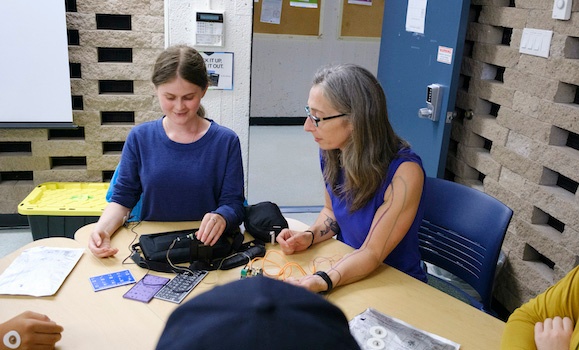While she has only just started the third year of an undergraduate degree in psychology, Gabrielle Close knows the human brain inside and out.
вҖңGabrielle is an absolute wizard with her hands,вҖқ says Dr. Jennifer Stamp, a university teaching fellow in the Department of Psychology & Neuroscience. вҖңShe can assemble and disassemble brain models faster than anyone else, including me, and I have a PhD and a postdoc in neuroanatomy.вҖқ
ThereвҖҷs something else that sets Gabrielle apart: she is blind. She learned neuroanatomy using special, 3D anatomical models of the brain. While the use of brain models can be incorporated into the anatomy curriculum for all learners, they are of particular importance to visually impaired students like Gabrielle, who cannot rely on images.
Getting comfortable at Dal
Gabrielle took orientation and mobility lessons before coming to Dal that prepared her to navigate to her classes without assistance. вҖңI like to be as self-sufficient as possible,вҖқ she says, noting that she tries to space out her class schedule to ensure that she has plenty of time to get around.
GabrielleвҖҷs early days on campus took some getting used to. вҖңThere were a lot of accommodations that needed to be put in place on the fly that I never encountered before,вҖқ she says. вҖңI was learning along the way, just like my professors, but once we got into a rhythm with my classes and what was needed, things really started to pick up.вҖқ
Recommended reading: When a little effort goes a long way
Gabrielle has been working with a group of students, instructors and teaching assistants (TAs) known as Team Visual Assist, whose work Dr. Stamp describes as вҖңa grassroots attempt to get the supports in place for instructors when faced with the sudden appearance of a visually impaired student in their class.вҖқ
This summer, Gabrielle and the team reviewed the effectiveness of tactile resources put in place in five courses taken during her first two years at Dal.
вҖңI provided feedback on our tactile books, models, and teaching assistant services to determine what worked, what didnвҖҷt work, and what would work better in the future,вҖқ Gabrielle says. вҖңWe started developing new methods and ideas to improve accessibility moving forward.вҖқ
Developing an inclusive curriculum
Following GabrielleвҖҷs decision to major in psychology after her first year, Dr. Stamp coordinated with DalвҖҷs accommodations team to develop specialized resources in time for her second year. Already working with a group of TAs and student volunteers, Dr. Stamp formed Team Visual Assist to gather feedback on what they tried.
The most effective accommodations are a mix of tools and practices, some of which are relatively simple and cheap вҖ” such as Braille signage in learning spaces and open-book, online exams, which allows for the use of assistive technology. Other accommodations require additional costs and expertise from the teaching team.
The 3D brain models Gabrielle used to learn neuroanatomy are expensive and require one-on-one sessions with an instructor or TA to cover key concepts. The production of tactile вҖңtouchyвҖқ texts вҖ” with raised line images and Braille descriptions вҖ” can be expensive and time-intensive, especially if outsourced, so the team would like to produce these in-house.
Support for Team Visual AssistвҖҷs summer work came from the Faculty of Science and a retired faculty member. That provided salaries for three students, while two others joined as volunteers. In GabrielleвҖҷs first year, graduate student Filip Kosel volunteered his time to design a 3D receptor model, printed in-house at Dal for low cost.
вҖңA lot of this work has been funded by student enthusiasm,вҖқ says Dr. Stamp.
Incorporating elements of Universal Design for Learning into the curriculum helps reduce the number of accommodations required. вҖңThe concept of universal design comes from architecture,вҖқ Dr. Stamp says. вҖңIf you have the choice to build stairs or a ramp, always choose the ramp. For example, the 3D receptor models were perfect for Gabrielle, but they are also great for sighted students, especially those that might have reading challenges.вҖқ
Showcasing science
This summer, Gabrielle joined Dr. StampвҖҷs outreach team for camps, helping demonstrate concepts in psychology and neuroscience, including a вҖңmind controlвҖқ activity where campers controlled the arms of volunteers using electrodes connected to the ulnar nerve. Another activity used Braille clues as part of a scavenger hunt.
вҖңI was happy we put that in place because it highlights that people with disabilities like me can participate in science,вҖқ Gabrielle says, noting that the 3D brain models were also popular among campers.
While Gabrielle still faces challenges as a blind student, her contributions to Team Visual Assist will ideally make things easier for future visually impaired students and their instructors. вҖңItвҖҷs a wonderful, collaborative project and everyone involved is contributing,вҖқ she says.
Team Visual Assist is:
В·В В В В В Dr. Jennifer Stamp, psychology and neuroscience instructor
В·В В В В В Gabrielle Close, third-year psychology student
В·В В В В В Inaya Seraj, third-year neuroscience student, project manager
В·В В В В В Can Sozuer, accessibility-experienced TA, neuroscience and math alum
В·В В В В В Basmah Hendy, third-year neuroscience student
В·В В В В В Isaac Zacher, fifth-year neuroscience student

